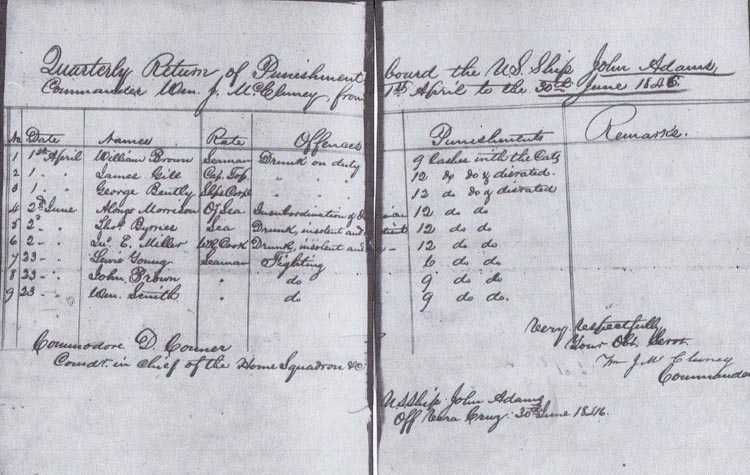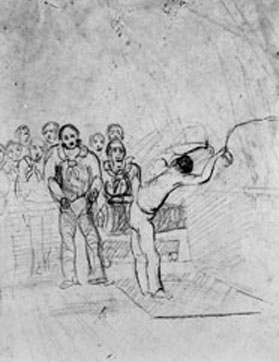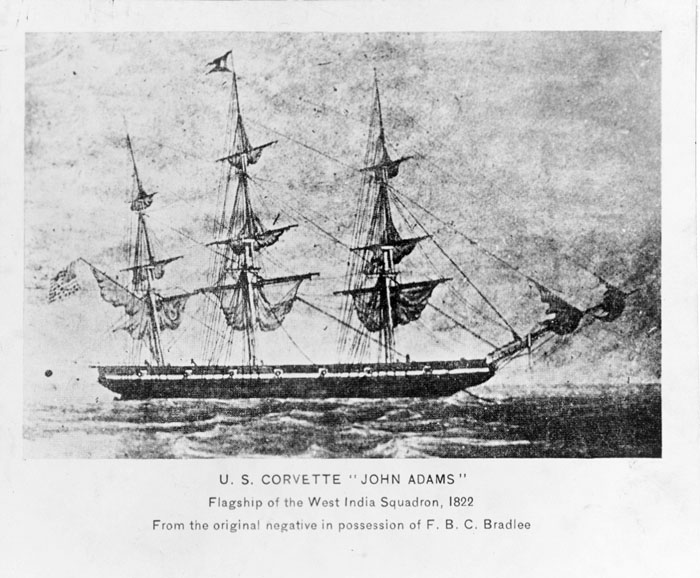Flogging at Sea, Discipline and Punishment in the Old Navy
by John G. M. Sharp
In the early United States Navy flogging was the most common means of enforcing discipline. Its defenders considered flogging swift and effective, in contrast to confinement; it quickly returned a sailor to duty. The majority of naval officers, and probably some enlisted as well, believed that flogging was the only practical means of enforcing discipline on board ship.1 Nonetheless as critics of the practice grew more vocal, the U.S. Congress demanded the Department of the Navy compile statistics for flogging on each ship to track how pervasive and to what extent flogging was utilized. These reports began in the years 1846-1847. Also in 1846 in response to increased public and congressional complaints, the Secretary of the Navy set the legal limit for flogging at twelve lashes. Prior to this limitation in 1804, Captain Isaac Chauncey had once awarded a seaman 136 lashes.2 A court martial though could always award far more. In one notorious case in June 1804 Seaman, Robert Quinn, was sentenced for mutiny to 320 lashes.3
1 U.S. Naval Institute, Naval History Blog, “Flogging outlawed 160 Years ago Today” 28 September 2008, https://www.navalhistory.org/2010/09/28/flogging-outlawed-160-years-ago-today accessed 22 November 2020.
2 McKee, Christopher A Gentlemanly and Honorable Profession the Creation of the United States Naval Officer Corps 1794-1815 (U. S. Naval Institute Press: Annapolis MD 1991), p. 243. Captain Isaac Chauncey was in command of the USS John Adams from 1804-1805. Also see Sharp, John G.M. A Documentary History of the New York (Brooklyn) Navy Yard 1806-1856, 2019, pp. 5-6, accessed 20 November 2020. http://www.usgwarchives.net/va/portsmouth/shipyard/brooklyn-sharp.html
3 Sharp, John G M., The Deck Log, Journals & Letters of the Frigate USS Constitution 1798-1815 http://www.usgwarchives.net/va/portsmouth/shipyard/constitution-decklog-1.html
Fortunately a few of the 1846-1847 disciplinary reports have survived and transcribed below are two examples from the 20 gun sloop of war USS John Adams. The Adams served in the Mexican-American War, anchored off the bar at Santiago Mexico from 8 May 1846 during the Battle of Palo Alto. The Adams principal duty was to maintain a blockading station off the east coast of Mexico. Periodically the Adams and other American vessels in support bombarded various Mexican military installations along the coast.4 The two reports dated 1846 and 1847 give some idea of the type of infractions subject to corporal punishment. In 1846 the Muster Roll of the officers and crew of the John Adams reflect a total of 192 officers and men. In 1847 the Muster Roll of the officers and crew of the John Adams reflect a total of 187 officers and men.
4 New York Daily Herald (New York, New York), 29 March 1847, p. 2.
Both reports provide examples of shipboard discipline. For instance on 1 April 1846, George Bentley, Ship’s Cooper was punished with twelve lashes for being drunk on duty and “disrated”, that is reduced in rate. While all the details are not available, Bradley may have succumbed to temptation and tapped into the John Adams kegs and barrels. As ships cooper Bradley’s normal assignments included checking the integrity of wooden casks and barrels. Barrels and kegs were vital in the premodern navy and these containers were mostly the vessel's essential water supply for the crew, some however were filled with wine, whiskey or other spirits used in making the daily grog ration or for the officers mess.
In year 1847, the disciplinary reports involving flogging aboard the USS John Adams doubled. This increase may be due to the sloop’s prolonged mission blockading off Mexico. The Adams crew also suffered various illnesses such as scurvy and yellow fever that forced it to periodically return to Pensacola Navy Yard.5, 6 In the 1847 report John Walch, Ordinary Seamen, was punished with twelve lashes with the Cat of Nine Tails for disobedience to orders”, while his shipmate John Lewis, Seaman, was punished with twelve lashes for “Insolence.”7 Captain William J. McCluney could award up to 12 lashes on his own authority, but for seaman with multiple infractions such as theft, desertion and drunkenness he could and did award more lashes as separate counts. Such was the case of Seaman John Murray who on 10 June 1847 incurred the lesser penalty of ten lashes with the Colt for “disobedience to orders”, and in a separate instance on 10 June 1847 was punished again with the Colt with 12 lashes for fighting. Likewise John Neville, Seaman received 12 lashes for “disobedience” on 12 April 1847 and 12 more lashes with the Colt on 11 June 1847 for "fighting”. As can be seen most entries in the “Punishment Returns of the John Adams” were concerned with drunkenness, fighting and related activities. One such related incident was David Parks, a Seaman, who on 10 May 1847 received 12 lashes for “stealing liquor from tub.” Naval grog was mixed and distributed from a large tub which was typically a large barrel for distribution twice daily. Parks apparently took more than the allotted ration either from the tub or the spirit room, both offenses punishable by flogging.
5 The Spirit of Democracy (Woodfield Ohio), 17 October 1846, p. 2, “…sloop John Adams to leave for Pensacola in a few days on account of sickness. “
6 The Evening Post (New York, New York) , 10 0ctober 1846, p. 3.
7 Sharp, John G.M. The Ship Log of the frigate USS United States 1843-1844 and Herman Melville Ordinary Seaman, 2019, pp 3-4, accessed 18 October 2020 http://www.usgwarchives.net/va/portsmouth/shipyard/usunitedstates-hmelville
In total for the years 1846-1847, the Department of the Navy, reported 5,036 floggings had been administered on sixty ships. This averages out to roughly fifty flogging per ship per year or four per month.8 Corporal punishment of boys or young apprentices was administered with a lighter but still painful scourge known as the colt. In the United States Navy, corporal punishment was typically awarded for being absent without leave, drunkenness, disobedience and insubordination.9 Such punishment could also be awarded for sleeping on watch, theft, smuggling and fighting. Despite mounting criticism and public outcry, flogging in the 1840’s remained a common punishment in almost all American men-of-war until its abolition in 1850.
8 Parker, Hershel, Herman Melville A Biography Volume 1, 1819-1851 (Baltimore, The Johns Hopkins, University Press, 1996), 78 and 262.
9 Langley, Howard D., Social Reform in the United States Navy 1798 -1862 (University of Illinois Press, Chicago), 1967 p. 172.
Quarterly Return of Punishment a board the U.S. Ship John Adams 1 April to 30 June 1846Flogging was carried out by the cat-of-nine tails made from a thick rope as a handle and nine pieces of light line, knotted in places, with which the offender was whipped on the bare back.10 For lesser offense or for young boys, the colt or rope end was made to inflict pain but without stripping the victim.11 Noted author Herman Melville who sailed as an Ordinary Seaman on the frigate USS United States in 1844, later recounted his experiences in White Jacket how the vessel’s crew was assembled with the Boatswain shouting, “All hands to witness punishment, ahoy!” Next the marines and boatswain mates led out the malefactor. The spectacle of flogging was meant to inspire fear in the ship crew, thereby deterring misconduct and ensuring obedience to naval law. The seaman being punished was tied to a grating taken from one of the hatches. His wrists and ankles were then tied to the grate and his back stripped. The Master at Arms or the Boatswain was then ordered to cut him with the cat.12 All the ship’s officers and men were required to attend and witness punishment. Typically punishment formations were conducted following weekly Divine Services. During Melville’s fourteen months aboard the USS United States, the log records the crew witnessed one hundred and sixty-three floggings, some on the author’s first morning aboard.
10 Naval History and Heritage Command, Brief History of punishment by Flogging in the U.S. Navy, https://www.history.navy.mil/research/library/online-reading-room/title-list-alphabetically/b/brief-history-punishment-flogging-us-navy.html accessed 22 November 2020
11 Valle, James E., Rocks and Shoals Naval Discipline in the Age of Fighting Sail (United States Naval Institute, Annapolis, 1980), p. 81.
12 Melville, Herman, White Jacket or the World in a Man-of-War, G. Thomas Tansselle editor (Library of America, New York, 1983), chapter 33.
Melville later utilized his hard won experiences and those of his shipmates in White-Jacket; or The World in a Man-of-War first published in London in 1850. The book is based on his fourteen months of service in the United States Navy, aboard the frigate. White-Jacket was published in London by Richard Bentley on February 1, 1850, and in New York by Harper & Brothers on March 21, 1850. That same year at the urging of New Hampshire Senator John P. Hale, the United States Congress banned flogging on all U.S. ships on 28 September 1850, as part of a then-controversial amendment to a naval appropriations bill and the era of corporal punishment aboard U.S. Navy vessels was at an end.
In 1855 Congress provided a new system of discipline based on rewards and punishments. Congress established the summary court-martial for minor offences and prescribed a set of punishments, including bad-conduct discharge, solitary confinement in irons for up to thirty days, confinement for up to two months, reduction in rating, deprivation of liberty, extra police duties and loss of pay. For well-behaved sailors, Congress established honorable discharges, reenlistment bounties, and leaves of absences.13
13 U.S. Naval Institute, Naval History Blog, Flogging outlawed 160 Years ago Today, 28 September 2008, https://www.navalhistory.org/2010/09/28/flogging-outlawed-160-years-ago-today accessed 22 November 2020.
Transcription, Job Titles, Terminology and Abbreviations: This transcription of was made from images provided by National Archives and Records Administration, Washington DC, Record Group 45, Miscellaneous Records of the Navy Department. Both reports were filed under Muster Rolls, Quarterly Returns of Punishment for the USS John Adams 1846-1847.
In transcription, I have striven to adhere as close as possible to the original in spelling, capitalization, punctuation and abbreviation, however I have replaced all ditto marks, with repetition, to allow for improved formatting and legibility. The spelling, capitalization and punctuation of the period are retained throughout. Brackets [ ] were employed to denote either illegible or simply a complete word or words missing. In naval logs of this period, shortened versions of words were indicated by beginning the word in regular-sized letters and ending with superscript; for example, given names are often abbreviated as Jno for John, Jas for James and Michl for Michael. Sea is the abbreviation for Seaman, while “O Sea” and “O.S.” are both abbreviations for Ordinary Seaman. At the bottom of the hierarchy of enlisted ratings in the 1840’s was the Landsman. A Landsman was a person with no seagoing experience. Next was Ordinary Seaman, that is those men with some competency at sea but typically less than three years of service. A seaman was an enlisted rating reserved for men with more than three years at sea and of proven familiarity with all aspects of naval service. The Ship Cooper was in charge of the manufacture and repair of barrels. These wooden containers were used to store liquids and essential food supplies such as salt beef or pork and other containers. The Ship Cooper also was expected to maintain and repair the kegs for wine and whiskey.
In the early United States Navy, the Master at Arms was a senior enlisted man whose duty was to provide good order and discipline aboard ship over the enlisted crew and to administer such disciplinary orders as the ship’s captain should approve. The Master at Arms was responsible for keeping a log of all infractions, from which these Quarterly Returns were prepared.
The abbreviation “W.R.Cook”, is for Ward Room Cook. The Ward Room Cook was the principle cook who made meals for the ships officers. The abbreviation “Cap Top” is for Captain of the Topsail; typically this was a senior seaman who was in charge of top or uppermost sails of the vessel. The Captain of the Top was expected to lead the men assigned to this most difficult and dangerous task. Lastly to “disrate” in naval parlance is to reduce a sailor in rating or rank. For the malefactors listed below such actions meant both a loss of pay and status.
John G.M. Sharp 25 November 2020
Quarterly Return of Punishment of the U.S. Ship John Adams
Commander Wm. J. McCluney, 1st April to 30 June 1846 14, 15
14 Commodore William J McCluney USN (1796 -1864) was commissioned as a Midshipman in the United States Navy on January 1, 1812, and was assigned to the USS Wasp during the War of 1812. He took part in the capture of the British warship "HMS Frolic", and became a prisoner of war a few days later after the "Wasp" was herself captured by the "HMS Poitiers". He was promoted Lieutenant on April 1, 1818, Commander on December 9, 1839, Captain on October 13, 1851 and Commodore on the Retired List on July 16, 1862. He was in command of the "USS Powhatan" during Commodore Matthew Perry's 1853 Expedition to Japan. From 1858 to 1860 he was commander of the United States Navy's Atlantic Squadron. He was in command of the Home Squadron at the outbreak of the Civil War, commanding it until December 1861, when he was retired.
14 Miscellaneous Records Of The Navy Department, Muster Rolls, USS John Adams 1846, Quarterly Returns of Punishment 1 April to 30 June 1846, pages 3-4, NARA, RG 45.16 Brown,William, Seaman, joined the crew 1 July 1845, New York City.
17 J Gill, James, Captain of the Foretop, joined the crew 1 July 1845, New York City.
18 Brown, John, Seaman, joined the crew 1 July 1845, New York City.
Very Respectfully your Obedient Servant, W. J. McCluney, Commodore
[To] Commodore D. Comer, Commander in Chief of the Home Squadron, &c U.S. Ship John Adams off Vera Cruz, 30 June 1846
* * * * * * * * * *
Quarterly Return of Punishment aboard the U.S. Ship John Adams
Commander Wm. J. McCluney, from 1st April to the Quarter ending June 11th 184719
19 Miscellaneous Records Of The Navy Department, Muster Rolls, USS John Adams 1847, Quarterly Returns of Punishment 1 April to 30 June 1847, page 1, NARA, RG 45.
20 Neville, John, Seaman, joined the crew, 1 July 1845, New York City.
21 Langley, Howard D., Ibid, pp 172-173. Naval grog was mixed and distributed from a tub which was typically a large barrel for distribution twice daily. Taking more than the allotted ration either from the tub or the spirit room was punishable by flogging.
"Taken from the log book and record kept by the Master at Arms, inflicted by order of Commander Wm. J. McCluney."
* * * * * * * * * *
John "Jack" G. M. Sharp resides in Concord, California. He worked for the United States Navy for thirty years as a civilian personnel officer. Among his many assignments were positions in Berlin, Germany, where in 1989 he was in East Berlin, the day the infamous wall was opened. He later served as Human Resources Officer, South West Asia (Bahrain). He returned to the United States in 2001 and was on duty at the Naval District of Washington on 9/11. He has a lifelong interest in history and has written extensively on the Washington, Norfolk, and Pensacola Navy Yards, labor history and the history of African Americans. His previous books include African Americans in Slavery and Freedom on the Washington Navy Yard 1799 -1865, Morgan Hannah Press 2011. History of the Washington Navy Yard Civilian Workforce 1799-1962, 2004.
https://www.history.navy.mil/content/dam/nhhc/browse-by-topic/heritage/washington-navy-yard/pdfs/WNY_History.pdf
and the first complete transcription of the Diary of Michael Shiner Relating to the History of the Washington Navy Yard 1813-1869, 2007/2015 online:
https://www.history.navy.mil/research/library/online-reading-room/title-list-alphabetically/d/diary-of-michael-shiner.html
His most recent work includes Register of Patients at Naval Hospital Washington DC 1814 With The Names of American Wounded From The Battle of Bladensburg 2018,
https://www.history.navy.mil/research/library/online-reading-room/title-list-alphabetically/r/register-patients-naval-hospital-washington-dc-1814.html
The last three works were all published by the Naval History and Heritage Command. John served on active duty in the United States Navy, including Viet Nam service. He received his BA and MA in History from San Francisco State University. He can be reached at sharpjg@yahoo.com* * * * * * * * * *
Norfolk Navy Yard Table of Contents
Birth of the Gosport Yard & into the 19th Century
Battle of the Hampton Roads Ironclads


